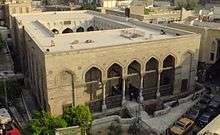Al-Salih Tala'i Mosque
| al-Salih Tala'i Mosque | |
|---|---|
 | |
| Basic information | |
| Location | Cairo, Egypt |
| Affiliation | Islam |
| Year consecrated | 1160 |
| Ecclesiastical or organizational status | Mosque |
| Leadership | al-Salih Tala'i' ibn Ruzzik |
| Architectural description | |
| Architectural type | Mosque |
| Architectural style | Fatimid |
| Completed | 1160 |
| Specifications | |
| Dome(s) | 1 |
| Minaret(s) | 2 |
The Mosque of Al Salih Tala'i (Arabic: مسجد الصالح طلائع ) is a late Fatimid-era mosque commissioned by the vizir Tala'i ibn Ruzzik in 1160. It is located south of Bab Zuweila, just outside the southern entrance to the old walled city of Cairo.
It was originally built to be the resting place of the head of Husayn, the grandson of 'Ali revered as a martyr by Shi'as, but this ended up in a shrine at the al-Hussein Mosque instead, further north.[1] The mosque was constructed on a raised platform whose base, at street level, had built-in recesses on three sides (all except the qibla side) designed to host shops which contributed to the revenue of the mosque.[2][3] Today, these shops are nearly two metres below the current street level, illustrating how much the ground level has risen in the city since the 12th century.[4]
The decoration of the mosque includes blind keel-shaped arches on the outside facade, while the interior displays carved wooden tie-beams, Qur'anic inscriptions in Kufic style on the outlines of arches in the prayer hall, and window grilles carved in stucco (an original example of which is now in the Museum of Islamic Art in Cairo). Some of these decorative elements continued to appear in post-Fatimid architecture in Cairo.[5]
The mosque was restored in the Mamluk era after an earthquake in 1303 which destroyed the minaret that stood over the front porch of the mosque. At this time bronze facings in the Mamluk style were added to the original main doors which had been carved in wood. Today the doors are replaced by replicas while the originals, featuring both the Mamluk bronze-faced and Fatimid wood-carved facades, are on display at the Museum of Islamic Art.[6] The minbar inside the mosque also dates from the Mamluk era (around 1300) and was a gift of the Mamluk amir Baktimur al-Jugandar.[7]
-

The prayer hall, with calligraphic stucco outlines around the arches and carved wooden tie-beams.
-
A stucco-carved window grille.
-

The mihrab and minbar.
-

Exterior of the mosque. The old spaces for shops, now half-buried and below street level, are visible along the base.
References
- ↑ Raymond, André. 1993. Le Caire. Fayard, p. 65.
- ↑ Raymond, André. 1993. Le Caire. Fayard, p. 65
- ↑ Williams, Caroline. 2008 (6th ed.). Islamic Monuments in Cairo: The Practical Guide. Cairo: American University in Cairo Press, p. 104.
- ↑ Raymond, André. 1993. Le Caire. Fayard, p. 65.
- ↑ O'Kane, Bernard (with contributions by Mohamed Abbas and Iman R. Abdulfattah). 2012. The Illustrated Guide to the Museum of Islamic Art in Cairo. Cairo, New York: The American University in Cairo Press, p. 80.
- ↑ O'Kane, Bernard (with contributions by Mohamed Abbas and Iman R. Abdulfattah). 2012. The Illustrated Guide to the Museum of Islamic Art in Cairo. Cairo, New York: The American University in Cairo Press, p. 80.
- ↑ Williams, Caroline. 2008 (6th ed.). Islamic Monuments in Cairo: The Practical Guide. Cairo: American University in Cairo Press, p. 104.
Coordinates: 30°02′32″N 31°15′28″E / 30.04222°N 31.25778°E
| Wikimedia Commons has media related to Al-Salih Tala'i Mosque. |